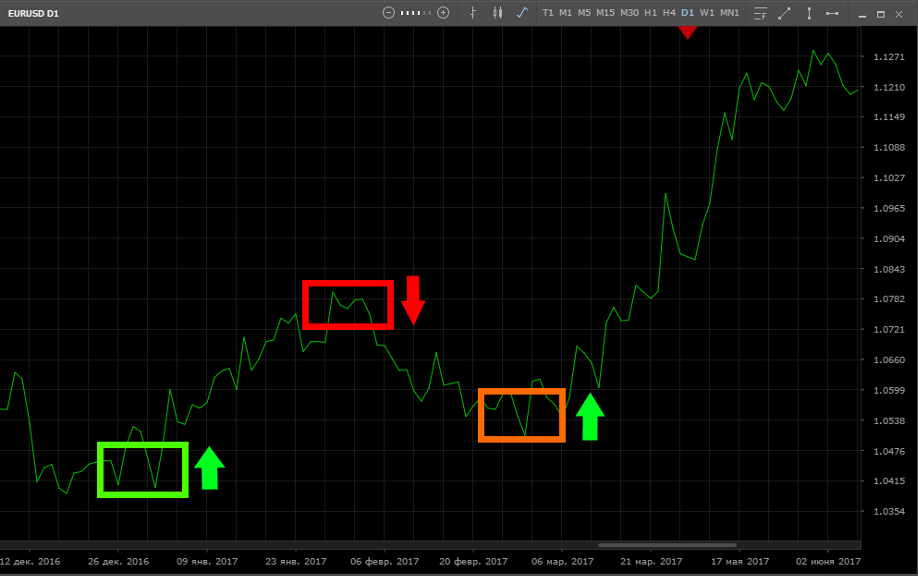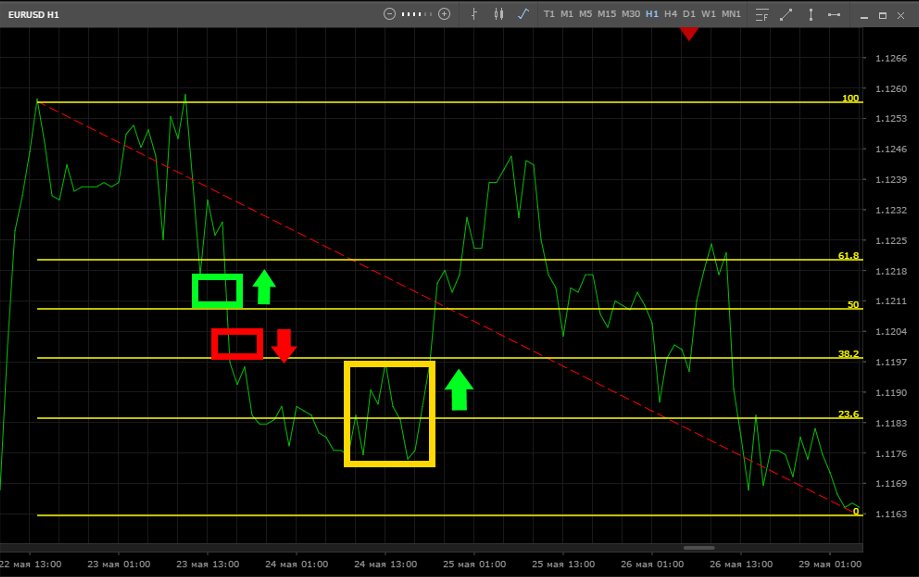Locking a position. Advantages and disadvantages
Today we’ll talk about locking positions. A trading technique that is known as a “lock” or “castle” has both fans and opponents, discussions between both sides do not stop from the moment this method is formalized as a technical strategy with a temporary fixation of profit or loss. What is she like?
Opening a position of equal volume and opposite direction against an existing one on the same instrument. Partial locking is possible when we open a deal with a volume less than the existing one.
A somewhat illogical at first glance trading solution?
How appropriate is its use?
In what cases can it be justified?
We will consider these questions further.
The use of locking when trading in the direction of the main trend.
The golden rule of the trader is “trend is my friend”. The logical consequence of this statement is that positions should be opened only in the direction of the prevailing trend. That's right, but there is one “but.” As is obvious the price does not go in a straight line. There are corrections whose depth is difficult to predict. And considering that the positions that we managed to open precisely according to the trend quite often fall into the zone of corrective pullback, this causes psychological discomfort and uncertainty, especially for beginning traders.
If a trader assumes that the phase of the trend movement is completed and the rollback begins, the question arises before him, but what if the whole current trend is not yet complete? Should I close the position or wait? And having closed it, you won’t enter immediately, since there is a great risk of getting under correction and getting a loss.

Here the locking technique comes to the rescue. What happens if the problem described above is solved simply by opening a position in the opposite direction? Upon the opening of such a position, the current profit will be recorded and in case of correction, essentially, the trader is in the market and has the opportunity to “roll back” and open the “lock” at the end of the correction phase of the movement to stay in trend with an open profit position. Indeed, when moving along a trend, at least the price updates the local extreme and rises higher. In addition, there remains the profit of the work in the correction, which is recorded on the account balance.
In addition, in terms of money management, when a counter position is opened using the “lock” technique, the trader also receives at the disposal the amount of margin collateral that can be used on other instruments if necessary.
Also, do not forget about psychological comfort. Taking profits to the castle gives you time to calmly analyze the situation.
Graphic illustration
Description of objects in the picture below.
The green square is the buy entry zone at the breakdown of the critical level (the direction is the green arrow).
The red square is the zone of entry into the sale during the breakdown of the critical level against the trend (entrance to the LOC) direction, red arrow.
The yellow square is the decision-making area either to close a locking position (in this case, a sell position) or transfer it to breakeven.

Applying locks as an alternative to stop order
The second application of the locking technique is its alternative to placing a stop order, which is used to protect the trader’s account from excessive losses. Obviously, many witnessed the picture when, after the stop was triggered, the price moves for some short time against the initial position (which was closed at a loss) and then reverses and successfully passes the level of its opening, and then reaches the order point the take profit set at closed at a loss warrant.
When placing an order using the lock technique, at least the trader has the opportunity to make sure that he correctly determined the level at which this order worked as a protective one and in case of a final break of the level, simply close both positions thereby fixing a loss. But in this case, the decision will be completely conscious.
If the price makes a reversal at the point where the locking order will be in the profit zone, the trader will have the opportunity to analyze the possibility of resuming the trend and either close the lock or transfer it to the breakeven level and try to play the trend with the original position again.
As a plus of technology in this case, we have time for analysis, without increasing the loss on the incorrectly opened initial position, with the possibility of obtaining additional profit with a locking order, and the account balance will not be affected.
Graphic illustration
Description of objects in the picture below.
The green square is the buy entry zone when the rollback level reaches 50% according to the Fibonacci levels. The green arrow is the direction of trade.
The red square is the area of placing a pending sell order when a level of 38.2% Fibonacci expansion is broken. The red arrow is the direction of trade from the level.
The yellow square is the end of the correction and the pivot zone where the decision is made to close the locking position or to transfer it to breakeven.

U-Turn
When a critical level is broken, a position is opened against an existing one, but in a doubled volume. That is, in fact, there is a reversal in the opposite direction.
This technique can be recommended in manual trading - but two conditions must be met!
1. An order of this type is set only at a critical level and only works after it is broken! Remember you are trading against the trend you must have a large number of reasons for such actions.
2. If you are a beginner - No further coups!
Conclusion from the above.
Inconsistent at the beginning, the solution is successfully applied as one of the elements of trading equipment in the implementation of various trading strategies.
General summary of the use of locking positions in trading:
maintains the balance of the account and does not injure the psyche, as when triggering stop orders;
It provides an opportunity for additional profit both in case of application when trading on a trend and when working out corrections.
But technically, the strategy is complex and requires experience and knowledge when analyzing the structure of price movement before applying it.
It is also necessary to recognize that the castle is not a panacea for all ills and it is quite possible to build a trading strategy without using it. It can be considered as an element of the psychological preparation of the trader to limit losses during trading. Purely mathematically - lock does not give any advantages other than psychological.

 Russian
Russian  中文
中文  العربي
العربي  Bahasa Indonesia
Bahasa Indonesia